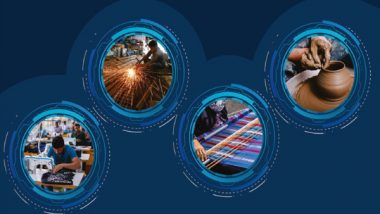New Delhi [India], November 29 (ANI): By 2047, domestic manufacturing and services sectors are poised to drive India's economic transformation, employing 67 per cent of the workforce and contributing over three-quarters of the GDP, according to the ASSOCHAM-Egrow report.
The report identifies significant opportunities for businesses in manufacturing, services, and MSMEs (Micro, Small, and Medium Enterprises).
India's nominal GDP is projected to grow from USD 3.5 trillion in 2023 to USD 22.8 trillion by 2047, with an annual growth rate of 7.5 per cent. The services sector is expected to dominate, increasing its contribution to GDP from 54.2 per cent in 2023 to 60 per cent by 2047.
Manufacturing is set to witness modest growth, accounting for 18 per cent of GDP, while agriculture's share is projected to decline significantly to 10 per cent. These changes reflect India's ongoing transition from an agriculture-based economy to one driven by services and manufacturing.
Employment trends also highlight this shift. The services sector is expected to employ 52.3 per cent of the workforce by 2047, compared to just 24.3 per cent in 2000.
In contrast, agriculture's share of employment is anticipated to drop sharply from 59.4 per cent to 22 per cent. Manufacturing employment is projected to rise from 10.9 per cent in 2023 to 15 per cent in 2047, showcasing opportunities for businesses in industrial growth and technology-driven production.
MSMEs, which currently contribute 30 per cent to GDP and 45 per cent to exports, hold immense potential for growth through formalisation, technology adoption, and productivity enhancement.
The government's emphasis on formalising the sector creates opportunities in areas like financial services, skill development, and tech integration.
Foreign Direct Investment (FDI) will play a crucial role in India's economic transformation. With the government focusing on gross fixed capital investment, the continuation of business-friendly policies and incentives is expected to attract foreign investors.
For businesses, this translates to expanding opportunities in high-tech manufacturing, exports, and services. India's workforce is set to grow significantly, with employment projected to reach 76.9 crore by 2047, supported by a working-age population of 118.4 crore.
This vast labour pool represents a strategic advantage, but ensuring its readiness for evolving industry needs will require substantial investment in skill development.
Businesses can play a pivotal role by contributing to training and upskilling initiatives, preparing the workforce for emerging opportunities in technology-driven industries.
As India progresses toward its goal of achieving a per capita income of USD 14,000 by 2047, the path ahead involves balancing economic growth with inclusivity and sustainability. (ANI)
(This is an unedited and auto-generated story from Syndicated News feed, LatestLY Staff may not have modified or edited the content body)













 Quickly
Quickly

















